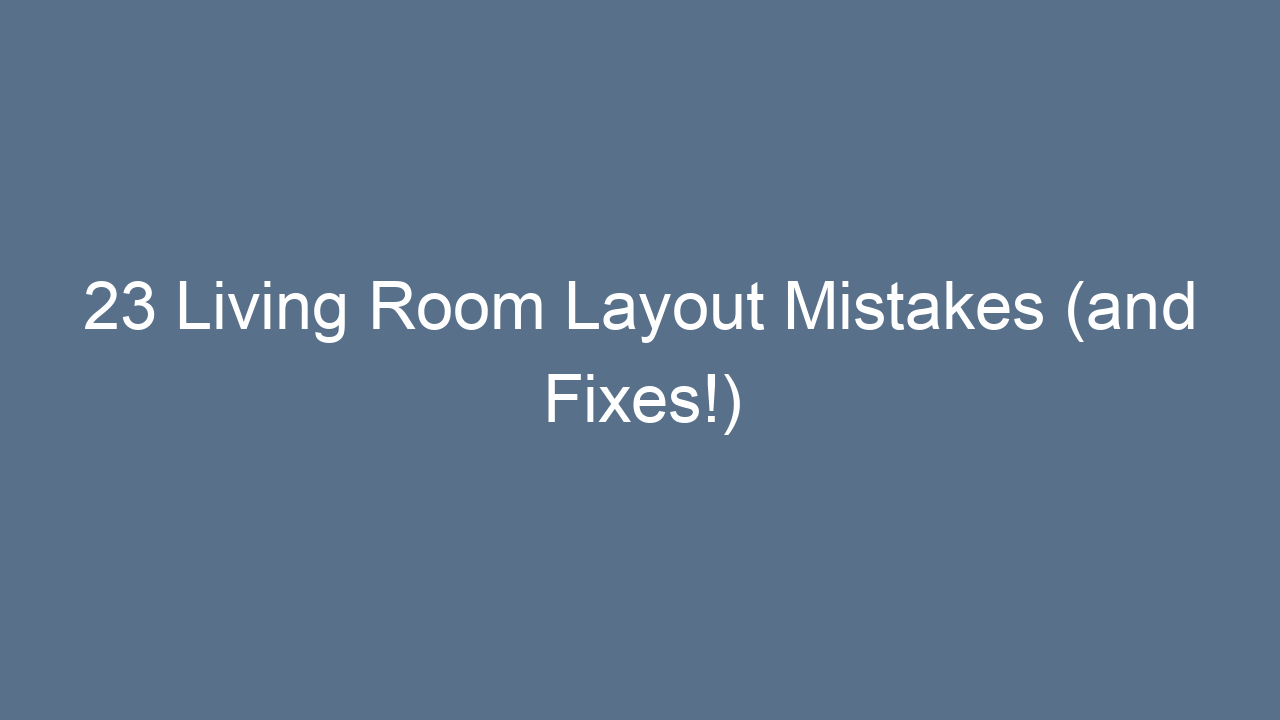23 Living Room Layout Mistakes (and Fixes!)

Designing a living room can feel like solving a puzzle. You want the space to feel cozy, stylish, and functional, but sometimes things don’t quite work out. The truth is, most people unknowingly make small living room layout mistakes that throw the whole vibe off balance. Maybe your sofa is too big for the space, or your rug looks lost in the middle of the floor. The good news? Every mistake has a simple fix.
In this article, we’ll walk through 23 common living room layout mistakes—and the smart solutions that can turn your space from awkward to amazing. Think of it as having a friend over who gently points out what’s not working and shows you a better way. Let’s dive in!
In This Article
- 1 1. Blocking Natural Light
- 2 2. Pushing All Furniture Against the Walls
- 3 3. Using the Wrong-Sized Rug
- 4 4. Choosing Oversized Furniture
- 5 5. Ignoring Traffic Flow
- 6 6. Centering Everything Around the TV
- 7 7. Forgetting a Focal Point
- 8 8. Skipping Side Tables
- 9 9. Cluttering with Too Many Pieces
- 10 10. Neglecting Vertical Space
- 11 11. Poor Lighting Mix
- 12 12. Using Only One Seating Type
- 13 13. Ignoring Conversation Zones
- 14 14. Forgetting Balance and Symmetry
- 15 15. Overlooking Scale of Accessories
- 16 16. Not Defining Spaces in Open Layouts
- 17 17. Forgetting Flexibility
- 18 18. Placing Furniture Too Close to the Door
- 19 19. Ignoring Acoustics
- 20 20. Forgetting Personal Touches
- 21 21. Skipping Storage Solutions
- 22 22. Choosing Style Over Comfort
- 23 23. Not Updating the Layout Over Time
- 24 Final Thoughts
1. Blocking Natural Light
One of the biggest mistakes is placing bulky furniture right in front of a window. Natural light is like free magic for a living room—it makes everything feel fresh, bright, and welcoming. When you block it, the room feels dull and smaller than it is.
Fix: Position your sofa or large chairs away from windows. If you must place furniture nearby, use low-backed pieces or transparent items like acrylic chairs. This keeps the light flowing while still giving you seating.
2. Pushing All Furniture Against the Walls
It might feel natural to shove your sofa against one wall and the chairs against another. But this creates an empty, awkward middle space and makes the room feel more like a waiting area than a cozy living room.
Fix: Float your furniture. Pull sofas and chairs a few inches (or even feet) away from the walls. Use rugs to anchor them, and you’ll instantly create a warm, conversational zone.
3. Using the Wrong-Sized Rug
Rugs are like frames for a painting. Too small, and the room looks disconnected. Too large, and it swallows the furniture. Many people buy rugs that barely fit under the coffee table, leaving the seating area floating around it.
Fix: Ideally, the front legs of your sofa and chairs should rest on the rug. For larger rooms, all legs can sit on it. When in doubt, size up.
4. Choosing Oversized Furniture
We’ve all seen it—a giant sectional sofa squeezed into a modest living room. Oversized furniture makes the room feel cramped and leaves little space to move around.
Fix: Measure before you buy. Use painter’s tape on the floor to map out dimensions. Opt for slim, scaled-down furniture with clean lines if your living room is small.
5. Ignoring Traffic Flow
If you constantly bump into the corner of a table or squeeze sideways between the sofa and wall, it means the traffic flow wasn’t considered. Poor layouts disrupt movement and make the space frustrating.
Fix: Leave at least 2–3 feet of walking space in pathways. Place furniture in a way that allows easy movement from one side of the room to another without obstacles.
6. Centering Everything Around the TV
It’s tempting to make the TV the star of the room. But when all seating points toward it, your living room feels more like a theater than a social space.
Fix: Treat the TV as one part of the design, not the main event. Arrange furniture in a circle or U-shape so conversations feel natural. Mount the TV on a wall to save space.
7. Forgetting a Focal Point
Without a focal point, a living room feels aimless. Your eyes don’t know where to land, and the room lacks personality.
Fix: Create a focal point, whether it’s a fireplace, a gallery wall, or even a bold rug. Arrange furniture around it to give the room balance and direction.
8. Skipping Side Tables
If you’ve ever had to stretch awkwardly to put your coffee down on a distant coffee table, you know the pain of missing side tables.
Fix: Add small tables beside sofas and chairs. They don’t need to match—mix materials like wood, glass, or metal for charm. Just make sure they’re at arm’s reach.
9. Cluttering with Too Many Pieces
Sometimes in an effort to decorate, people fill their living room with too many chairs, ottomans, and shelves. The result? Chaos.
Fix: Less is more. Focus on functional pieces you actually use. Leave breathing space between items for a more relaxed, open feel.
10. Neglecting Vertical Space
All the attention often goes to the floor, leaving walls bare and ceilings ignored. This can make even large living rooms feel short and cramped.
Fix: Use tall bookshelves, floor lamps, or wall art to draw the eye upward. Curtains hung closer to the ceiling also create height and drama.
11. Poor Lighting Mix
Relying on a single overhead light is a mistake that makes the room look flat. A living room should feel layered and cozy, not like a hospital waiting area.
Fix: Use a mix of lighting—floor lamps, table lamps, sconces, and dimmers. Layered light creates warmth and mood.
12. Using Only One Seating Type
A sofa alone won’t cut it. When guests come over, you’ll run out of comfortable spots quickly.
Fix: Mix seating options—sofa, accent chairs, poufs, or even a bench. Variety makes the room flexible and welcoming.
13. Ignoring Conversation Zones
A common mistake is spacing furniture so far apart that people have to raise their voices to talk.
Fix: Keep chairs and sofas close enough for easy conversation. A good rule: seating should be within 8–10 feet of each other.
14. Forgetting Balance and Symmetry
When everything sits on one side of the room, the layout feels lopsided. It’s unsettling, even if you can’t pinpoint why.
Fix: Balance furniture visually. If you have a heavy sofa on one side, add chairs or shelving on the other. Symmetry doesn’t have to be perfect—just balanced.
15. Overlooking Scale of Accessories
A giant lamp on a tiny side table or a small piece of art on a huge wall makes the room feel off.
Fix: Match accessory size with furniture and wall space. Large walls need big artwork, and oversized sofas need bold lamps.
16. Not Defining Spaces in Open Layouts
In open-plan homes, the living area often blends into the dining or kitchen. Without clear zones, everything feels jumbled.
Fix: Use rugs, furniture placement, or even open shelving to define zones. Each space should have its own identity while still feeling connected.
17. Forgetting Flexibility
A rigid layout that doesn’t adapt makes the room less usable. Life changes—you may need space for guests, hobbies, or kids.
Fix: Choose lightweight, movable furniture. Nesting tables, foldable chairs, or poufs add flexibility to change layouts easily.
18. Placing Furniture Too Close to the Door
When furniture blocks the entrance, the room feels cramped and unwelcoming.
Fix: Keep entryways clear. Arrange furniture so you step into an open area, not the back of a sofa.
19. Ignoring Acoustics
Hard surfaces everywhere—tile floors, bare walls, and glass—create echo and noise. This makes the room feel cold.
Fix: Add rugs, curtains, cushions, and soft furniture. These absorb sound and make the room feel cozy.
20. Forgetting Personal Touches
A layout can be technically perfect but still feel lifeless without personal elements.
Fix: Add family photos, souvenirs, or heirlooms. A personal touch grounds the space and makes it feel like home.
21. Skipping Storage Solutions
Living rooms often turn into clutter zones without smart storage.
Fix: Use ottomans with hidden storage, media consoles with drawers, or stylish baskets. They keep things tidy while adding style.
22. Choosing Style Over Comfort
A sleek sofa might look great but feel awful to sit on. A layout that looks good but isn’t livable won’t last.
Fix: Test furniture before buying. Comfort should come first, especially in the living room where you relax most.
23. Not Updating the Layout Over Time
Life changes, but many people stick with the same layout for years. The result? A room that no longer fits your lifestyle.
Fix: Revisit your layout regularly. Move pieces around, swap rugs, or rehang art. Small changes can breathe new life into the space.
Final Thoughts
Your living room is more than just a place to watch TV—it’s where life happens. By avoiding these 23 living room layout mistakes and applying their simple fixes, you can create a space that feels balanced, cozy, and true to your personality. The best layouts aren’t perfect blueprints; they’re living, breathing arrangements that evolve with you. So, take a look at your living room today. Is it welcoming, functional, and stylish—or is there room for improvement? With a few tweaks, you can turn it into a space you truly love.






